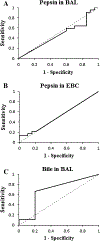The diagnostic value of gastroesophageal reflux disease (GERD) symptoms and detection of pepsin and bile acids in bronchoalveolar lavage fluid and exhaled breath condensate for identifying lung transplantation patients with GERD-induced aspiration
- PMID: 24414458
- PMCID: PMC6607894
- DOI: 10.1007/s00464-013-3388-3
The diagnostic value of gastroesophageal reflux disease (GERD) symptoms and detection of pepsin and bile acids in bronchoalveolar lavage fluid and exhaled breath condensate for identifying lung transplantation patients with GERD-induced aspiration
Abstract
Background: Gastroesophageal reflux disease (GERD) is thought to lead to aspiration and bronchiolitis obliterans syndrome after lung transplantation. Unfortunately, the identification of patients with GERD who aspirate still lacks clear diagnostic indicators. The authors hypothesized that symptoms of GERD and detection of pepsin and bile acids in the bronchoalveolar lavage fluid (BAL) and exhaled breath condensate (EBC) are effective for identifying lung transplantation patients with GERD-induced aspiration.
Methods: From November 2009 to November 2010, 85 lung transplantation patients undergoing surveillance bronchoscopy were prospectively enrolled. For these patients, self-reported symptoms of GERD were correlated with levels of pepsin and bile acids in BAL and EBC and with GERD status assessed by 24-h pH monitoring. The sensitivity and specificity of pepsin and bile acids in BAL and EBC also were compared with the presence of GERD in 24-h pH monitoring.
Results: The typical symptoms of GERD (heartburn and regurgitation) had modest sensitivity and specificity for detecting GERD and aspiration. The atypical symptoms of GERD (aspiration and bronchitis) showed better identification of aspiration as measured by detection of pepsin and bile acids in BAL. The sensitivity and specificity of pepsin in BAL compared with GERD by 24-h pH monitoring were respectively 60 and 45 %, whereas the sensitivity and specificity of bile acids in BAL were 67 and 80 %.
Conclusions: These data indicate that the measurement of pepsin and bile acids in BAL can provide additional data for identifying lung transplantation patients at risk for GERD-induced aspiration compared with symptoms or 24-h pH monitoring alone. These results support a diagnostic role for detecting markers of aspiration in BAL, but this must be validated in larger studies.
Conflict of interest statement
Figures

Similar articles
-
The protective role of laparoscopic antireflux surgery against aspiration of pepsin after lung transplantation.Surgery. 2011 Oct;150(4):598-606. doi: 10.1016/j.surg.2011.07.053. Surgery. 2011. PMID: 22000170 Free PMC article.
-
Pepsin concentrations are elevated in the bronchoalveolar lavage fluid of patients with idiopathic pulmonary fibrosis after lung transplantation.J Surg Res. 2013 Dec;185(2):e101-8. doi: 10.1016/j.jss.2013.06.011. Epub 2013 Jun 29. J Surg Res. 2013. PMID: 23845868 Free PMC article.
-
Gastro-oesophageal reflux and gastric aspiration in lung transplant patients with or without chronic rejection.Eur Respir J. 2008 Apr;31(4):707-13. doi: 10.1183/09031936.00064807. Epub 2007 Dec 5. Eur Respir J. 2008. PMID: 18057058
-
A review of the potential applications and controversies of non-invasive testing for biomarkers of aspiration in the lung transplant population.Clin Transplant. 2010 May-Jun;24(3):E54-61. doi: 10.1111/j.1399-0012.2010.01243.x. Epub 2010 Mar 19. Clin Transplant. 2010. PMID: 20331688 Free PMC article. Review.
-
Diagnosis and management of GERD before and after lung transplantation.Thorac Surg Clin. 2011 Nov;21(4):499-510. doi: 10.1016/j.thorsurg.2011.08.006. Epub 2011 Sep 9. Thorac Surg Clin. 2011. PMID: 22040632 Review.
Cited by
-
Bronchoalveolar bile acid and inflammatory markers to identify high-risk lung transplant recipients with reflux and microaspiration.J Heart Lung Transplant. 2020 Sep;39(9):934-944. doi: 10.1016/j.healun.2020.05.006. Epub 2020 May 19. J Heart Lung Transplant. 2020. PMID: 32487471 Free PMC article.
-
Unraveling the causality between gastroesophageal reflux disease and increased cancer risk: evidence from the UK Biobank and GWAS consortia.BMC Med. 2024 Aug 7;22(1):323. doi: 10.1186/s12916-024-03526-5. BMC Med. 2024. PMID: 39113061 Free PMC article.
-
Management of microaspiration and gastrointestinal dysfunction after lung transplantation: A narrative review.JHLT Open. 2025 Aug 8;10:100363. doi: 10.1016/j.jhlto.2025.100363. eCollection 2025 Nov. JHLT Open. 2025. PMID: 40893636 Free PMC article. Review.
-
Gastroesophageal reflux disease and non-esophageal cancer.World J Gastroenterol. 2015 Jan 21;21(3):815-9. doi: 10.3748/wjg.v21.i3.815. World J Gastroenterol. 2015. PMID: 25624714 Free PMC article. Review.
-
Gastroesophageal Reflux Disease.Pediatr Clin North Am. 2017 Jun;64(3):487-505. doi: 10.1016/j.pcl.2017.01.003. Pediatr Clin North Am. 2017. PMID: 28502434 Free PMC article. Review.
References
-
- Christie JD, Edwards LB, Kucheryavaya AY, Benden C, Dobbels F, Kirk R, Rahmel AO, Stehlik J, Hertz MI (2011) Registry for the International Society for Heart and Lung Transplantation: twenty-eighth official adult lung and heart/lung transplantation report—2011. J Heart Lung Transplant 30:1104. - PubMed
-
- Brown RS, Rush SH, Rosen HR (2004) Liver and intestine transplantation. Am J Transplant 4(Suppl 9):81. - PubMed
-
- Wynn JJ, Distant DA, Pirsch JD (2004) Kidney and pancreas transplantation. Am J Transplant 4(Suppl 9):72 - PubMed
-
- Pierson RN III, Barr ML, McCullough KP (2004) Thoracic organ transplantation. Am J Transplant 4(Suppl 9):93. - PubMed
Publication types
MeSH terms
Substances
Grants and funding
LinkOut - more resources
Full Text Sources
Other Literature Sources
Medical

